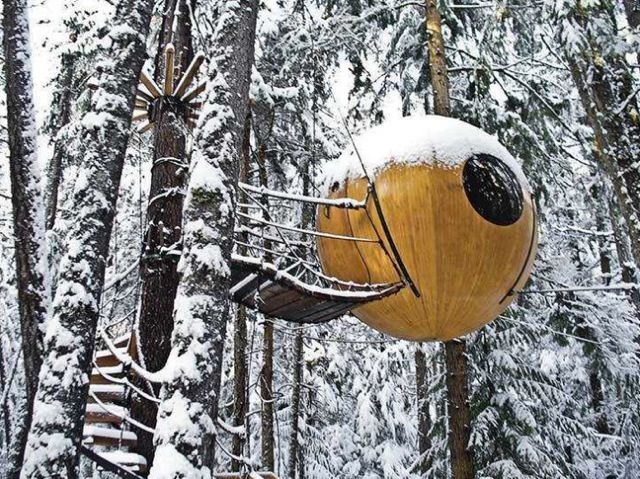
When the Whole Earth Catalog first appeared in 1968, it electrified those of us with the itch to build. Subtitled “Access to Tools,” it was like a gigantic toolbox with every gizmo and gadget imaginable, whether for renovating a house, growing a garden or changing the world. Decades later, Apple’s Steve Jobs said of the WEC, “It was sort of like Google in paperback, 35 years before Google came along.”
The shelter editor of the WEC was a plucky fellow named Lloyd Kahn, whose straight-up descriptions and love of things ingenious caught my eye at the time. And still do. For though the Age of Aquarius disappeared long ago in a cloud of smoke, Lloyd has kept on truckin’–turning out useful and beautiful books as Publisher of Shelter Publications. He also hosts Lloyd’s Blog which, though rich with photos of buildings, is basically about everything in the world that interests him. It’s one of the few sites I visit almost every day.
Of the many titles that Lloyd publishes, his building books continue to be my favorites. He is presently putting to bed a hand-crafted beauty, Tiny Homes, which should be in book stores in six months. I will be reviewing it. In the mean time, to whet your appetite and introduce you to Lloyd, here’s an excerpted review I wrote about his most recent book, Builders of the Pacific Coast. It will restore your sense of wonder.
—
“Whether you start with the Book of Genesis or the Adventures of Robinson Crusoe, we humans have long loved tales about creating a new world–or building one from scratch. Lloyd Kahn’s recent book, Builders of the Pacific Coast, is primarily an account of builders and hand-crafted structures dating from the ’60s to the ’80s. Yet the rugged coastal setting of his odyssey–a blue and green world from California’s Point Reyes Peninsula to Vancouver Island–invokes a simpler, more pristine time, an Eden of sorts. When forests grew down to the sea, building codes were few, lumber was plentiful (often free) and anyone with skill, a strong back and the courage to try could create something beautiful and enduring.
“That second attribute, ‘enduring,’ is worth noting. The Pacific Northwest, which gets up to 200 inches of rain a year, is one of most challenging places on earth for things made of wood. Ignore the details and in a decade your house will be humus.
“So as free-flowing and exotic as many of BPC’s buildings are, they are decidedly not hippie shacks. Almost all of the structures were built by professional builders at the top of their game and the level of craft, ingenuity and attention to detail is mind-bending.
“It takes great skill, for example, to join factory-milled 2×10s at a roof peak, but inspired madness to converge 21 hand-peeled Douglas fir rafter poles-trees, really-atop an 800-year-old salvaged old-growth redwood log serving as a home’s center post. But for every ponderous tour de force with big timber, there’s something delicate and whimsical, such as the elegant spherical tree houses built ‘much like a cedar-strip kayak’ and hung among three trees with fittings originally intended to secure sailboat masts. The sphere’s builder notes, ‘When it’s stormy things can be tense, but nothing like a storm at sea…’
“To document this riot of creativity, Kahn took 10,000 photos and selected 1200 for the book. On every page is something shocking and delightful. A boat with legs. A roof like a leaf. A caravan with eyes. A split-cedar woodshed shaped like a bird. Stair rails so sinuous and snakey they might come to life and grab you. Sculpted earth walls. Round windows and arched doors. Roofs curved like seagull wings. Grottos choked with ferns and flowers. All that’s lacking is a hobbit with a long clay pipe.
“Not that there’s any shortage of creatures and fantastical characters. Just off-camera lurk orcas, eagles and bears. (Well, not entirely off-camera. One page features a tiny photo of bear scat: some days they eat nothing but blackberries and the by-product is a deep purple pile of poop.) And then there are the builders themselves. There hasn’t been a cast of characters this colorful since Ken Kesey packed up his Underwood….
“This joyful book is, in many ways, the culmination of more than forty years of hard work. Almost everywhere he went, Lloyd Kahn was welcomed as a friend and mentor. All the builders had copies of the Whole Earth Catalog, of which he had been shelter editor, and many had copies of his 1973 classic Shelter, which had inspired and empowered them to build their own houses. So his trips up north must have felt like a homecoming of sorts.
“When I visited Lloyd a couple months ago at his office in Bolinas, he had this to say: ‘The Catalog was a profound tool and the ’60s had a huge influence on what’s going on now. Back then, we were talking about treating the earth right, alternative sources of energy, building out of natural sustainable materials–green building–that is now front and center in people’s minds. The movements of the ’60s didn’t fail, everybody just dispersed, scattered like seeds. So these builders up north are success stories from the ’60s. These guys went out and did stuff and it worked.'”
© Michael Litchfield 2012
Fine Homebuilding Recommended Products
Fine Homebuilding receives a commission for items purchased through links on this site, including Amazon Associates and other affiliate advertising programs.

Graphic Guide to Frame Construction

Get Your House Right: Architectural Elements to Use & Avoid

Code Check 10th Edition: An Illustrated Guide to Building a Safe House



























